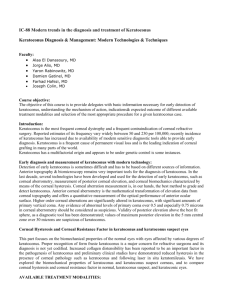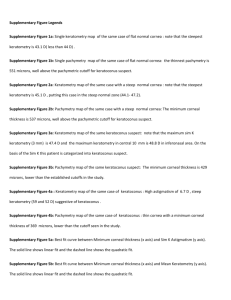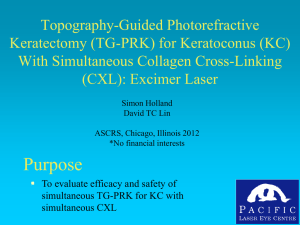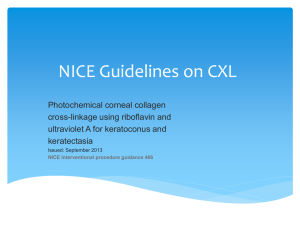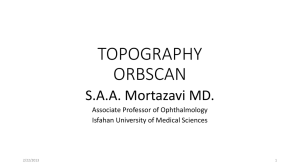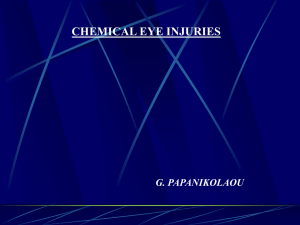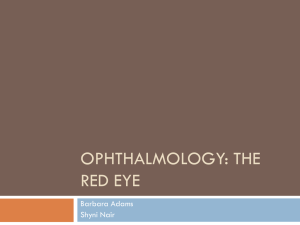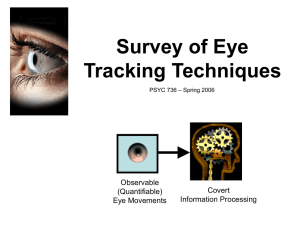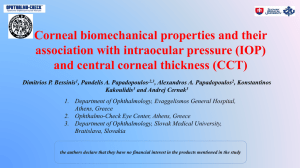Rotating Scheimpflug Topographic Parameters Important in
advertisement
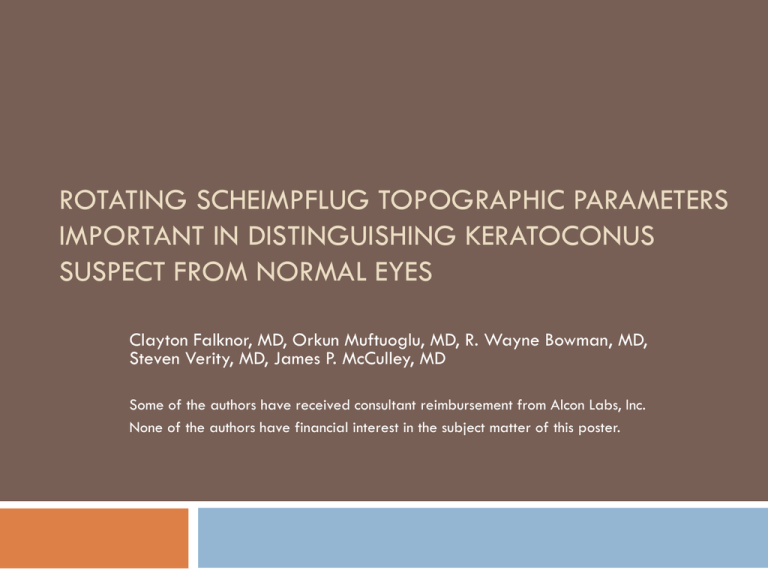
ROTATING SCHEIMPFLUG TOPOGRAPHIC PARAMETERS IMPORTANT IN DISTINGUISHING KERATOCONUS SUSPECT FROM NORMAL EYES Clayton Falknor, MD, Orkun Muftuoglu, MD, R. Wayne Bowman, MD, Steven Verity, MD, James P. McCulley, MD Some of the authors have received consultant reimbursement from Alcon Labs, Inc. None of the authors have financial interest in the subject matter of this poster. Iatrogenic corneal ectasia Complication of corneal refractive surgery Progressive corneal steepening, myopia, astigmatism, loss of BCVA Pre-operative risk factors Keratoconus is characterized by: Thin residual stromal bed after LASIK Forme fruste keratoconus or keratoconus Non-inflammatory, progressive corneal thinning and bulging Irregular astigmatism and myopia Potentially severe corneal scarring Keratoconus is identified by: Examination findings (Fleisher ring, Vogt striae, subepithelial fibrosis, stromal thinning, scissoring of retinoscopic reflex) Central or paracentral steepening on topography Subclinical keratoconus Traditional method to identify subclinical keratoconus is Placido disk-based corneal topography Reflection-based system Measures slopes of anterior corneal surface only Axial curvature method subject to misalignment of corneal apex and corneal sighting point Contribution of posterior corneal surface important Projection-based Orbscan systems (Bausch and Lomb, Salt Lake City, Utah, USA) Pentacam (Oculus Optikgeraete GmbH, Germany) Keratoconus suspects Topographic designation No evidence of keratoconus on examination Multiple methods to define Modified Rabinowitz/McDonnell method (central K steeper than 47.2D, I-S >1.4D) Maeda/Klyce KPI index Smolek/Klyce KSI index (based on >10 indices and neural network) KISA% (Rabinowitz) Pentacam Comprehensive Eye Scanner Rotating Scheimpflug camera Monochromatic slit light source rotates with camera 25-50 slit images per acquisition Eye movement monitoring by 2nd camera Less than 0.6mm decentration Rotates 180º in 2 seconds All images include central cornea Corneal elevation data independent of visual axis and corneal apex http://www.oculus.de/chi/downloads/dyn/sonstige/sonstige/pent acam_aao_2006.pdf Purpose Evaluate Pentacam parameters important in distinguishing keratoconus suspects from normal Pentacam parameters to detect keratoconus Pachymetry Progression index of corneal thinning Corneal volume within fixed diameter Keratometry readings and axis AC volume, depth and angle Posterior elevation over best-fit sphere (option of toric ellipsoid) Zernike HOA of anterior and posterior surfaces Corneal variance indices ISV (index of surface variance) IVA (index of vertical asymmetry) IHA (index of height asymmetry) IHD (index of height decentration) Rmin (radius minimum) KI (keratoconus index) CKI (center keratoconus index) Pentacam keratoconus identification Patients Controls (normals presenting for keratorefractive surgery) Keratoconus suspects 72 eyes of 41 patients Inclusion: underwent pre-operative screening for keratorefractive Sx, normal corneal exam, available topography maps Exclusion: prior ocular surgery or trauma, ocular disease likely to affect corneal HOA’s 15 eyes from 10 patients Selected from normals with keratoconus suspect indication by Smolek/Klyce KSI on topography. Keratoconus (diagnosed clinically with topography support) 108 eyes of 54 patients (34 men, 20 women) Inclusion: distorted keratometry mires, abnormal retinoscopic reflex, Vogt’s striae, Fleischer’s ring, corneal scarring, available topography maps Exclusion: prior corneal surgery, extensive corneal scarring Posterior corneal elevation Mean posterior elevation Keratoconus 98.7 ± 46.3 µm Keratoconus suspects 16.9 ± 6.1 µm Controls 8.6 ± 3.8 µm Table 1. Sensitivity and specificity of posterior elevation cut-off points to detect keratoconus and keratoconus suspects Keratoconus Keratoconus suspects Cut-off point Sensitivity Specificity Sensitivity Specificity 10 100 0 93 61 15 100 12 67 91 20 100 53 20 100 25 100 66 20 100 30 96 84 0 100 35 93 94 0 100 40 89 98 0 100 45 86 100 0 100 (µm) Pentacam keratoconus parameters Table 2. Comparison of Pentacam parameters between keratoconus suspect and normal eyes Keratoconus Suspect Control Mean ± SD Mean ± SD P* Corneal Vol (7mm diam) 23.7 ± 1.3 24.3 ± 1.8 0.264 K Thinning Prog Min 0.7 ± 0.5 0.6 ± 0.2 0.749 K Thinning Prog Avg 1.1 ± 0.6 0.9 ± 0.3 0.048 K Thinning Prog Max 1.6 ± 0.8 1.1 ± 0.5 0.011 K1 45.0 ± 2.5 42.7 ± 1.4 <0.001 K2 46. 3± 2.2 43.6 ± 1.6 <0.001 KAxis 94.2 ± 69.3 78.5 ± 65.1 0.332 Pachy Pupil (µm) 513 ± 40 538 ± 41 0.032 Pachy Thinnest (µm) 508 ± 40 536 ± 41 0.015 AC Vol (mm3) 192 ± 25 189 ± 49 0.394 AC Depth (mm) 3.39 ± 0.42 3.09 ± 0.28 0.004 AC Angle 43.6 ± 0.4 40.2 ± 7.0 0.122 Corneal variance indices Table 3. Comparison of Pentacam parameters between keratoconus suspect and normal eyes Keratoconus Suspect Control Mean ± SD Mean ± SD P* Sensitivity Specificity ISV 25 ± 12 19 ± 6 0.062 7 98 IVA 0.23 ± 0.17 0.18 ± 0.08 0.466 33 89 KI 1.04 ± 0.04 1.01 ± 0.03 0.007 20 98 CKI 1.00 ± 0.02 1.00 ± 0.01 0.537 7 100 IHA 9.4 ± 10.9 5.2 ± 3.8 0.360 13 100 IHD 0.017 ± 0.013 0.01 ± 0.005 0.008 53 79 Rmin 7.06 ± 0.24 7.58 ± 0.29 <0.001 7 100 ABR 1.4 ± 0.2 1.3 ± 0.5 0.727 100 9 Summary of results Maximum posterior corneal elevation For keratoconus For keratoconus suspect Cut-off of 35 µm, sensitivity 93% and specificity 95% Cut-off 15 µm, sensitivity 67% and specificity 91% Cut-off 10 µm, sensitivity 93% and specificity 61% Progression index average and maximum all significantly different in keratoconus suspects vs. controls Other significant parameters: Corneal variance parameters : KI, IHD, Rmin Pachymetry at pupil center and thinnest Keratometry (flat and steep) AC depth Zernike analysis Both anterior and posterior elevation data decomposed into Zernike higher-order aberration polynomials Real differences between keratoconus and controls within the third through sixth orders Anterior surface: vertical coma, trefoil Posterior surface: vertical coma, spherical aberration, and fifth-order vertical coma Pentacam for keratoconus Pentacam is useful for identifying keratoconus suspects Corneal variance parameters are set too high to capture keratoconus suspects, but specificity is excellent for confirmation purposes Best Posterior elevation cut-off between 10 and 15 µm. Important parameters include pachymetry, progression of corneal thinning, keratometry, corneal variance indices, and Zernike HOA’s (especially vertical coma)
